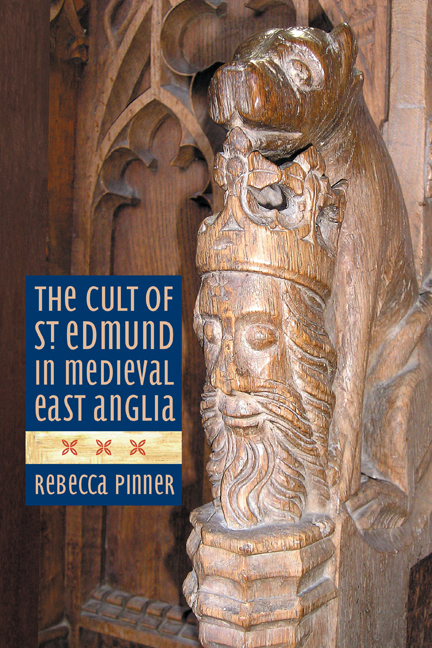Book contents
- Frontmatter
- Contents
- List of Illustrations
- Acknowledgements
- Abbreviations
- Introduction
- Part I Texts and Contexts: the Legend of St Edmund
- Part II Relics, Shrines and Pilgrimage: Encountering St Edmund at Bury
- Part III Beyond Bury: Dissemination and Appropriation
- Conclusion: ‘Martir, Mayde and Kynge’, and More
- Appendix 1 Synoptic Account of the Legend of St Edmund
- Appendix 2 Chronology of Significant Events and Texts Associated with the Cult of St Edmund
- Bibliography
- Index
Chapter 8 - Writing St Edmund into the East Anglian Landscape
Published online by Cambridge University Press: 21 May 2021
- Frontmatter
- Contents
- List of Illustrations
- Acknowledgements
- Abbreviations
- Introduction
- Part I Texts and Contexts: the Legend of St Edmund
- Part II Relics, Shrines and Pilgrimage: Encountering St Edmund at Bury
- Part III Beyond Bury: Dissemination and Appropriation
- Conclusion: ‘Martir, Mayde and Kynge’, and More
- Appendix 1 Synoptic Account of the Legend of St Edmund
- Appendix 2 Chronology of Significant Events and Texts Associated with the Cult of St Edmund
- Bibliography
- Index
Summary
The power of his moral excellence which brightly lights up England might be transferred through us to other parts of the world, and thus he may receive a worthy increase on account of his merits.
Dissemination and appropriation: the case of pilgrim badges
THUS far the focus has primarily been upon the development of Edmund's saintly identity at the cult centre: the hagiographic tradition which developed at the abbey, the miracles attributed to Edmund's uncorrupted remains and the devotional and iconographical setting of the shrine in the abbey church. However, in order to examine the true extent of the cult in its regional context it is necessary to move beyond Bury and consider the nature of devotion to St Edmund as manifested in a variety of contexts and locations throughout East Anglia.
Evidence of the cult in outlying areas of the region should not necessarily be taken as an indication of entirely independent devotional traditions, devoid of the abbey's influence. Pilgrim souvenirs are a good example of the way in which the cult could be disseminated throughout Norfolk and Suffolk, and further afield, through physical media. Although found throughout East Anglia and beyond, pilgrim badges were produced at Bury as mnemonic objects intended to perpetuate the pilgrims’ imaginative and emotional connections with St Edmund established during their time in his presence. Known by contemporaries as ‘signs’, they were worn as a marker of the pilgrimage undertaken by that individual. Marike De Kroon demonstrates that in many cases pilgrim badges reflected the actual experience of pilgrims by depicting images and architectural forms encountered by them at the shrine site, reinforcing their function as commemorative souvenirs. The role of pilgrim souvenirs as private devotional objects is attested by a number of badges either pasted or sewn into Books of Hours or depicted in the margins, attempting to capture the virtus of the object in paint. In addition, badges were also thought to possess their own physical efficacy. It was common practice to press souvenirs against the shrine in order that they might absorb some of the power of the remains within, transforming them into contact-relics and allowing pilgrims to carry home with them some of the saint's virtus.
- Type
- Chapter
- Information
- The Cult of St Edmund in Medieval East Anglia , pp. 169 - 180Publisher: Boydell & BrewerPrint publication year: 2015

